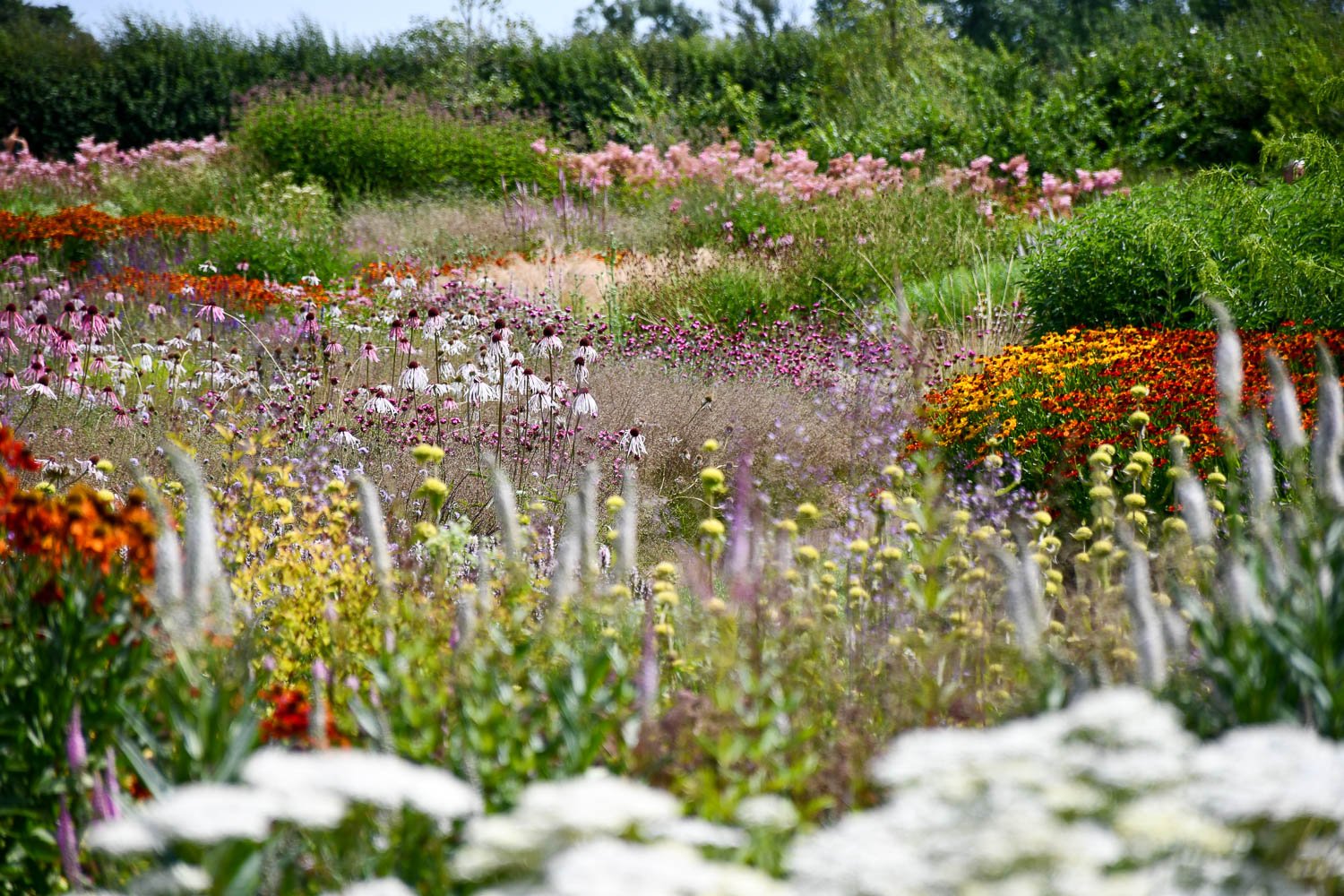A couple weeks ago I wrote about our morning visiting to Oudolf Field last summer on our trip to the UK. I felt the content too long to try to cover it all in one piece, so I decided to focus on overall design approaches for the first part and the plants for the second part. To walk through an Oudolf planting is a masterclass in planting design. To see the knowledge and experience that a man has observed and witnessed over a lifetime of working with plants made real in front of you creates for breathtaking scenes and pairing. What delights me is how simple some of them were, even if it was a bright morning with strong light that intensified the colors and made the shadows harsh.
Exploring Oudolf Field I was armed with a nice guide that I bought in the gift shop that showed a fold out of the design along with plants that were included in each section. I’ve used that to help me key out some of the plants included below. Feel free to let me know if you see any errata.
An analogous color scheme featuring reds, pinks, blues, and purples. A few of the stars include Helenium ‘Moerheim Beauty’ (sneezeweed), Veronicastrum virginicum ‘Erica’ (Culver’s root), Echinops bannaticus (globe thistle), Thalictrum delavayi (Chinese meadow-rue), and Eupatorium maculatum ‘Atropurpureum’ (spotted Joe Pye weed).
Near the entrance to Oudolf field were plants primarily in blocks where they could play off each other. For example, here the soft yellow of Nepeta govaniana (catmint) contrasts well with Echinops bannaticus (globe thistle).
Here you can see the repetition of white spikes of Lysimachia ephemerum (willow-leaved loosestrife) and Veronicastrum virginicum. Such repetition helps make a planting feel more cohesive.
And, just in case you couldn’t see how amazing Culver’s root is from the above image, here’s another featuring ‘Diane’. Wowzers! I don’t think I’ve ever seen Veronicastrum virginicum look this good in the US.
The silvery-blue satellite dishes of Eryngium alpinum (alpine sea holly) really pop against the chartreuse Sesleria autumnalis (autumn moor grass).
Phlomis russeliana (turkish sage) always has such good texture in the garden with the large leaves and butter-colored verticillasters, and its audacity here is softened by the slender Panicum virgatum ‘Shenandoah’ (switchgrass) and Persicaria amplexicaulis ‘Firedance’ (red bistort).
I loved the unruly looking Datisca cannabina (false hemp) next to the neat sombreros of Helenium ‘Moerheim Beauty’.
Piet Oudolf says that brown is a color, too, and that’s certainly true of these brown seedheads from Monarda bradburiana (Bradbury’s beebalm). I’m not sure how I feel about their early demise. It feels too soon with the riot of color around.
And, some of the pairings were so simple and easy. Take how the purple highlights in this clump of Pancium virgatum ‘Shenandoah’ (which I’ll add here looks a bit more purple than the maroon I’m used to) plays off the burgeoning spikes of Liatris spicata (dense blazing star).
In the middle of the field was the Sporobolus heterolepis meadow where many species erupted from the prairie dropseed haze, and with a good breeze it was fun to watch Dianthus carthusianorum (Carthusian pink) and Echinacea pallida (pale coneflower) straight species and ‘Hula Dancer’ dance in the wind.
I liked how the silvery Amorpha canescens (lead plant) amorphously blended into the silvery seedheads of prairie dropseed.
One of my absolute favorite combinations of the day featured the differing textures yet echoed colors of Sedum ‘Matrona’ (stonecrop), Allium christophii (Persian onion), and Sporobolus heterolepis.
Towards the back of the field, the plantings shifted more back into block style planting. From this angle, you can see a wonderful combination of purple plants featuring Symphyotrichum lateriflorum var. horizontale (horizontal calico aster), Stachys officinalis ‘Hummelo’ (betony), and Panicum virgatum ‘Shenandoah’. The glaucous Eryngium yuccifolium (rattlesnake master) punctuates the planting.
In some parts Nassella tenuissima (Mexican feather grass) was woven through the planting, and with the wind it added such movement to the planting.
It amazes me just how black Symphyotrichum lateriflorum var. horizontale gets in the UK, and really it is just that the plant is further north. For us, these asters tend to be green with a smudge of charcoal. And, how good is the aster paired with the dark inflorescences of Molinia caerulea 'Edith Dudszus' (purple moor grass) in the foreground!
Designers talk about transparent perennials, and I so wish that I could add Sanguisorba officinalis ‘Blackthorn’ (burnet) to my planting palette here in the south. It’s like looking at giant pink cupcake sprinkles—I just want to eat it up!
Karen stands for a sense of scale of the billowy Amsonia hubrichtii (Arkansas bluestar). Even in the UK, these bluestars can get huge!
A nice patch of the bronzed Aruncus ‘Horatio’ (hybrid goat’s beard) stands between a mammoth clump of Eupatorium maculatum ‘Atropurpureum’ and an elongating Symphyotrichum novae-angliae ‘Violetta’.
And, we saw many pollinators in the planting. I was delighted to watch this bee dot around on our native friend Asclepias incarnata (swamp milkweed), and when I got the photos on my computer, I was even more thrilled to see that I had captured some orange milkweed pollinia stuck to its feet!



















